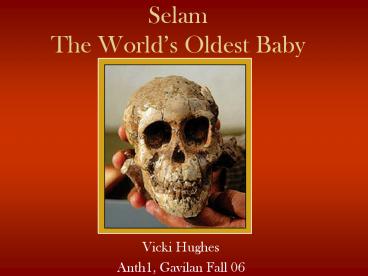Selam The World - PowerPoint PPT Presentation
Title:
Selam The World
Description:
Selam The World s Oldest Baby Vicki Hughes Anth1, Gavilan Fall 06 Mosaic Evolution Small-brained Projecting face Bipedal Gorilla-like Scapula Chimp-like Hyoid ... – PowerPoint PPT presentation
Number of Views:89
Avg rating:3.0/5.0
Title: Selam The World
1
SelamThe Worlds Oldest Baby
- Vicki Hughes
- Anth1, Gavilan Fall 06
2
Dikika (4 kilometers from Lucy)
3
Locked in Sandstone for 3.3 million years
4
Most Complete Ancient Infant
5
New Finds
1st afarensis Scapula found, good swinging /
climbing ability
Intact Hyoid Bone, chimp-like voice box and
speech
Curved fingers and toes, ability to climb. Biped
maybe lived in trees.
6
Mosaic Evolution
- Small-brained
- Projecting face
- Bipedal
- Gorilla-like Scapula
- Chimp-like Hyoid
- Curved Fingers Toes
- Dependent youth
This puts afarensis in a special position to
play a pivotal role in the story of what we are
and where we come from Zeresenay Alemseged, Max
Planck Institute
7
But the most impressive difference between them
is that this baby has a face Zeresenay
Alemseged
8
On December 10th in the year 2000, in Ethiopias
Afar region just four kilometers from where Lucy
was found, a 3.3 million year old fossil
belonging to a three-year old Australopithecus
afarensis was discovered. The team had been
digging in the Dikika region since early 1999 led
by Ethiopian paleoanthropologist Zeresenay
Alemseged. Dikika has a badlands reputation the
region is plagued by extreme heat, flash floods,
malaria not to mention lions, hyenas, and other
nocturnal guests. It is one of the most
difficult places on Earth to hunt for fossils-and
one of the most fruitful (Sloan, 2006). The team
had found many fossils of other mammals such as
elephants, hippopotamuses, rhinoceroses, and
antelopes, Zeresenay knew that the team was on
the right track he figured that if so many other
mammals were living around the ancestral Awash
River and the now gone shady woodlands that the
extinct afarensis would also be one of those
mammals. The fossil find is one of the most
exciting finds because the bones are so well
intact. The 3 year old Selam was found peering
out from a dusty slope and tucked behind her
intact skull was most of her upper torso that had
been locked in sandstone. Zeresenays not sure
how the baby died but suggests that the river
must have rapidly buried the body in pebbles and
sand, protecting it from scavengers and weather
before gradually hardening into rock. The task
of slowly etching away the hard sandstone from
the delicate bones of Selam has taken Zeresenay
over five years, and the task is still not
complete. But what has emerged from the
sandstone is a remarkably intact skeleton of a
three-year old Australopithecus afarensis that
lived 3.3 million years ago, pre dating Lucy by
more than 100,000 years. The skeleton consists of
a skull with brain endocast, full set of milk
teeth and un-erupted adult teeth, scapula, ribs,
spinal column, part of the humerus, several
curled fingers, parts of the femur, knee and
patella, tibia and fibula, and parts of the foot.
More importantly an understanding of how
afarensis children grow up to be adults is
emerging. Anthropologists in every field are
excited about learning what Selams skeleton can
tell us. Selams bones are said to be a good
example of mosaic evolution. Her remains have
both human-like and ape-like characteristics. Her
small brain, projecting face and the hyoid bone
mimic that of a chimp. The size of her brain and
the hint that at three her brain was no larger
than a chimps might mean that brain growth may
have started taking longer, a change that
prolonged the dependence of human young on their
parent (Sloan, 2006). It might have taken longer
to reach adult size which is a human trait. The
hyoid bone, which rarely ever found (the only one
found in a Neanderthal), appears to be like that
of a chimp, telling us that afarensis speech
pattern was very similar to a chimps. The
scapulas, the first to be found in this species,
are very gorilla-like in appearance and function.
Having an upward-facing shoulder socket may
indicate that afarensis was very good at
climbing. Which leads me to the fingers and toes,
they are curved which also aids in climbing.
The most important find with this skeleton has
got to be the fact that evolution selects for one
trait at a time. Afarensis was a capable biped
with ape-like arms and digits, A good example of
mosaic evolution (Wong, 2006), bipedalism was
selected for first in the lower limbs then in the
upper. Were getting to know more and more about
the sequences of changes that produced a
terrestrial biped from a tree-dwelling, apelike
creature (Wong, 2005)
9
Bibliography
1. (2006, 09/20 ). 'Lucy's baby, found in
Ethiopa'. Retrieved December 11, 2006, from BBC
News Web site http//news.bbc.co.uk/ go/pr/fr/-/1
/hi/sci/tech/5363328.stm 2. Wong, K (2006, Sep,
20th). Special Report Lucy's Baby. Scientific
American, Retrieved Dec 10, 2006, from
www.sciam.com/ print_version.cfm?articleID00076C
1D-62D1-1511-A2D183414B7F0000 3. Sloan,
Christopher (2006, November). Dikika Baby.
National Geographic, Retrieved Dec 10, 2006,
from http/ /www7.nationalgeographic.com/ngm/0611
/feature6/index.html































